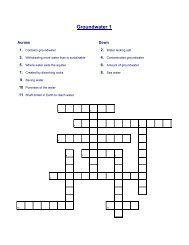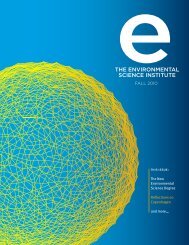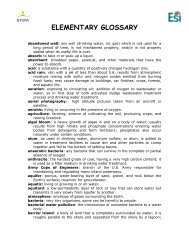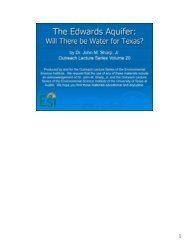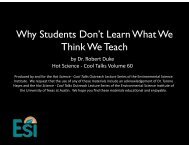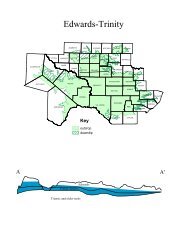Is Dilution the Solution to Pollution? - Environmental Science Institute
Is Dilution the Solution to Pollution? - Environmental Science Institute
Is Dilution the Solution to Pollution? - Environmental Science Institute
Create successful ePaper yourself
Turn your PDF publications into a flip-book with our unique Google optimized e-Paper software.
<strong>Is</strong> <strong>Dilution</strong> <strong>the</strong> <strong>Solution</strong> <strong>to</strong> <strong>Pollution</strong><br />
Subject: <strong>Science</strong> (Earth <strong>Science</strong>, Aquatic <strong>Science</strong>, <strong>Environmental</strong> <strong>Science</strong>)<br />
Grade level: 6-8<br />
Rationale or Purpose: This lab demonstrates <strong>the</strong> meaning of dilution and shows<br />
<strong>the</strong> possible disconnect between appearance and actual water quality.<br />
Materials:<br />
• two glass beakers for each team<br />
• eyedropper for each team<br />
• white egg car<strong>to</strong>n for each team<br />
• dye<br />
• tap water<br />
Lesson Duration: one 50-minute period<br />
Objectives:<br />
• <strong>Science</strong> 112.22 (1A), demonstrate safe practices during field and lab investigations<br />
• <strong>Science</strong> 112.22 (2B), collect data by observing and measuring<br />
• <strong>Science</strong> 112.22 (2C), analyze and interpret information <strong>to</strong> construct reasonable explanations<br />
• <strong>Science</strong> 112.22 (2D), communicate valid conclusions<br />
• <strong>Science</strong> 112.22 (4A), collect, analyze, and record information using <strong>to</strong>ols<br />
• <strong>Science</strong> 112.22 (7B), classify substances by <strong>the</strong>ir physical and chemical properties<br />
• <strong>Science</strong> 112.23 (1A), demonstrate safe practices during field and lab investigations<br />
• <strong>Science</strong> 113.23 (2B), collect data by observing and measuring<br />
• <strong>Science</strong> 112.23 (2C), analyze and interpret information <strong>to</strong> construct reasonable explanations<br />
• <strong>Science</strong> 112.23 (2D), communicate valid conclusions<br />
• <strong>Science</strong> 112.23 (4A), collect, analyze, and record information using <strong>to</strong>ols<br />
• <strong>Science</strong> 112.23 (7C), recognize that compounds are composed of elements<br />
• <strong>Science</strong> 112.23 (14C), draw conclusions about effects of human activities on <strong>the</strong> environment<br />
• <strong>Science</strong> 112.24 (1A), demonstrate safe practices during field and lab investigations<br />
• <strong>Science</strong> 112.24 (2B), collect data by observing and measuring<br />
• <strong>Science</strong> 112.24 (2C), analyze and interpret information <strong>to</strong> construct reasonable explanations<br />
• <strong>Science</strong> 112.24 (2D), communicate valid conclusions<br />
• <strong>Science</strong> 112.24 (4A), collect, analyze, and record information using <strong>to</strong>ols<br />
• <strong>Science</strong> 112.24 (12C), predict <strong>the</strong> results of modifying <strong>the</strong> Earth’s water cycle<br />
• <strong>Science</strong> 112.24 (14C), draw conclusions about effects of human activities on <strong>the</strong> environment<br />
Activity:<br />
Step 1: Ga<strong>the</strong>r all materials before class
Step 2: Introduce <strong>the</strong> <strong>to</strong>pic of pollution <strong>to</strong> <strong>the</strong> class and explore <strong>the</strong> different<br />
types of pollution in water. Show <strong>the</strong> class a clear glass of tap water and<br />
ask it is safe <strong>to</strong> drink. Ask why <strong>the</strong>y said yes or no.<br />
Step 3: Instruct students <strong>to</strong> immediately clean up any spilled water.<br />
Step 4: Describe <strong>the</strong> lesson steps:<br />
4a: Teacher will put 10 drops of dye in<strong>to</strong> cup #1 for each team.<br />
4b: Record <strong>the</strong> color of <strong>the</strong> liquid in cup #1 in <strong>the</strong> data table.<br />
4c: Using <strong>the</strong> eyedropper, students will take one drop from cup #1<br />
and place it in cup #2<br />
4d: Rinse eyedropper thoroughly in <strong>the</strong> rinse beaker.<br />
4e: Add 9 drops of water from <strong>the</strong> clean water beaker <strong>to</strong> cup #2.<br />
Carefully swirl <strong>the</strong> egg car<strong>to</strong>n <strong>to</strong> mix <strong>the</strong> contents.<br />
4f: Record <strong>the</strong> color of <strong>the</strong> liquid in cup #2.<br />
4g: Repeat steps 4c <strong>to</strong> 4f for each of <strong>the</strong> remaining cups. Each cup<br />
receives one drop from <strong>the</strong> preceding cup and 9 drops of clean<br />
water.<br />
Step 4: Have each team of students get tap water for each of <strong>the</strong>ir beakers;<br />
also ask <strong>the</strong>m <strong>to</strong> get one eyedropper per team and <strong>to</strong> number <strong>the</strong> cups of<br />
<strong>the</strong> egg car<strong>to</strong>n.<br />
Step 5: Students should complete <strong>the</strong> exercise and record all <strong>the</strong>ir data.<br />
Step 6: Direct students <strong>to</strong> clean up all materials.<br />
Step 7: Have students calculate <strong>the</strong> concentration for each cup by<br />
multiplying <strong>the</strong> original drop concentration (<strong>the</strong> concentration of <strong>the</strong> last<br />
cup from which you just <strong>to</strong>ok that drop) by <strong>the</strong> dilution fac<strong>to</strong>r.<br />
Step 8: Instruct students <strong>to</strong> complete <strong>the</strong> question sheet.<br />
Modification: none<br />
Student Product: Students will produce a data table and a completed question<br />
sheet on <strong>the</strong> exercise.<br />
Closure: Collect data tables and question sheets. Discuss several questions with<br />
<strong>the</strong> class:<br />
<strong>Is</strong> dilution <strong>the</strong> solution for pollution<br />
At what dilution level would you feel safe drinking water with gasoline<br />
How would you determine <strong>the</strong> dilution level that would be considered safe<br />
Are <strong>the</strong> safe levels <strong>the</strong> same for all people (i.e., children vs. adults)<br />
How can you safely dispose of water contaminated with gasoline<br />
Assessment or evaluation: Complete <strong>the</strong> attached grading rubric <strong>to</strong> evaluate<br />
students on correct lab practices, properly completed data table, and correctness of<br />
questions.<br />
Extension:<br />
1. Construct graphs (scatter plots with points connected) of <strong>the</strong><br />
concentration of <strong>the</strong> dye in each of <strong>the</strong> cups. Have students describe <strong>the</strong> shape of<br />
<strong>the</strong> data line and whe<strong>the</strong>r it ever hits zero. Discuss how <strong>the</strong>se lower amounts are<br />
detected.
2. Have students do research on how maximum contaminant levels are<br />
determined; this could include a discussion on <strong>the</strong> ethics of using animals <strong>to</strong> test<br />
contaminated water.<br />
3. Have students check with <strong>the</strong> local water company <strong>to</strong> find out <strong>the</strong> level of<br />
certain contaminants in your local drinking water. Compare <strong>the</strong>se <strong>to</strong> <strong>the</strong> federal<br />
standards. How do <strong>the</strong>se levels compare <strong>to</strong> <strong>the</strong> concentration of <strong>the</strong> dye in this<br />
experiment<br />
4. Complete this exercise again, but with diesel fuel. In this case, it is odor,<br />
not color which is <strong>the</strong> better detec<strong>to</strong>r of <strong>the</strong> pollutant. Or, complete with salt; make<br />
all <strong>the</strong> mixtures, <strong>the</strong>n taste <strong>the</strong>m (starting with <strong>the</strong> most dilute) until a salty flavor<br />
is detected.<br />
Dennis Ruez, Jr.<br />
<strong>Environmental</strong> <strong>Science</strong> <strong>Institute</strong>
<strong>Is</strong> <strong>Dilution</strong> <strong>the</strong> <strong>Solution</strong> <strong>to</strong> <strong>Pollution</strong><br />
Materials:<br />
• two glass beakers for each team<br />
• eyedropper for each team<br />
• white egg car<strong>to</strong>n for each team<br />
• dye (teacher will bring <strong>to</strong> each team)<br />
• tap water<br />
Procedures:<br />
1. Get all materials, except for <strong>the</strong> dye.<br />
2. Label one beaker “Rinse water” and <strong>the</strong> o<strong>the</strong>r “Clean water.”<br />
3. Number <strong>the</strong> cups in <strong>the</strong> egg car<strong>to</strong>n, 1 <strong>to</strong> 12.<br />
4. Have <strong>the</strong> teacher put 10 drops of dye in<strong>to</strong> cup #1.<br />
5. Record <strong>the</strong> color of <strong>the</strong> liquid in cup #1 in <strong>the</strong> data table.<br />
6. Using <strong>the</strong> eyedropper, take one drop from cup #1 and place it in cup<br />
#2.<br />
7. Rinse eyedropper thoroughly in <strong>the</strong> “Rinse water” beaker.<br />
8. Add 9 drops of water from <strong>the</strong> “Clean water” beaker <strong>to</strong> cup #2.<br />
Carefully swirl <strong>the</strong> egg car<strong>to</strong>n <strong>to</strong> mix <strong>the</strong> contents.<br />
9. Record <strong>the</strong> color of <strong>the</strong> liquid in cup #2.<br />
10. Repeat steps 6 through 9 for each of <strong>the</strong> remaining cups. Each cup<br />
receives one drop from <strong>the</strong> preceding cup and 9 drops of clean water.<br />
11. Clean up all materials.<br />
12. Calculate <strong>the</strong> concentration for each cup by multiplying <strong>the</strong> original drop<br />
concentration (<strong>the</strong> concentration of <strong>the</strong> last cup from which you just<br />
<strong>to</strong>ok that drop) by <strong>the</strong> dilution fac<strong>to</strong>r.<br />
13. Complete <strong>the</strong> question sheet.
Name: ____________________________________<br />
Date: ____________________<br />
<strong>Is</strong> <strong>Dilution</strong> <strong>the</strong> <strong>Solution</strong> <strong>to</strong> <strong>Pollution</strong><br />
Data Collection<br />
Cup # Color <strong>Dilution</strong> fac<strong>to</strong>r Concentration<br />
1 100%<br />
2<br />
3<br />
4<br />
5<br />
6<br />
7<br />
8<br />
9<br />
10<br />
11<br />
12<br />
Follow-up Questions<br />
1. A 10% solution of dye and water contains _________ parts of solution for every<br />
part of dye.<br />
2. Cup #2 is __________ times more dilute than cup #1.<br />
3. In cup #2 <strong>the</strong>re is __________ parts dye for every __________ parts solution.
4. In which cup does <strong>the</strong> solution first appear <strong>to</strong> be colorless.<br />
5. What is <strong>the</strong> concentration in that cup<br />
6. Do you think <strong>the</strong>re is any dye left in this cup even though it is colorless<br />
Explain.<br />
7. On your chart, label <strong>the</strong> cup that has a concentration of one part per million with<br />
“1 ppm” and <strong>the</strong> cup with a concentration of one part per billion with “1ppb.”<br />
Which is <strong>the</strong> greater concentration, 1 ppm or 1 ppb<br />
8. <strong>Is</strong> it possible for chemicals <strong>to</strong> be in drinking water that cannot be detected by<br />
<strong>the</strong> human eye or taste buds<br />
9. Name one helpful chemical that is put in<strong>to</strong> your drinking water intentionally by<br />
<strong>the</strong> water company. Why is this chemical used<br />
10. What can you do as an individual <strong>to</strong> make certain that harmful chemicals <strong>to</strong> not<br />
pollute your local drinking water<br />
11. Name one benefit <strong>to</strong> allowing companies <strong>to</strong> get rid of <strong>the</strong>ir chemical waste by<br />
diluting it in<strong>to</strong> lakes and streams. What is <strong>the</strong> disadvantage <strong>to</strong> this practice



